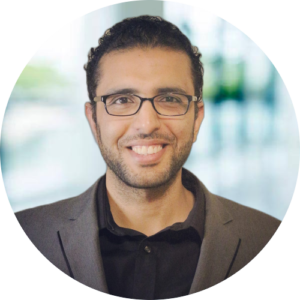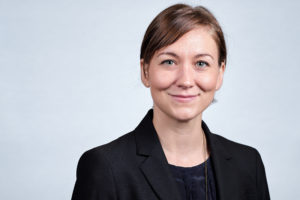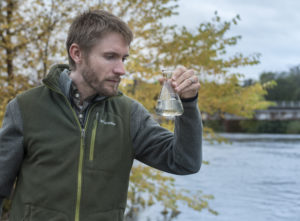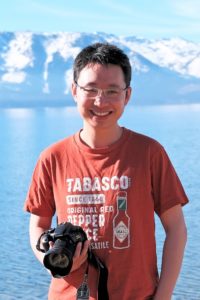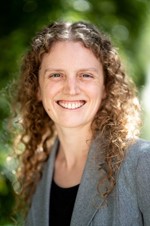 Rachel Scholes is an Assistant Professor in the Department of Civil Engineering at the University of British Columbia, where she leads a research group in environmental engineering. Her research focuses on trace organic contaminants and their fate in treatment systems for water and wastewater. Currently, her group is investigating photochemical transformations of emerging contaminants and the formation of oxidized and nitrogenous byproducts, as well as the fate of trace organic contaminants in nature-based treatment systems. Her research aims to address the implications of trace contaminants for human health, ecotoxicity, and the development of safer alternatives to hazardous chemicals. Prior to joining UBC, she completed a postdoctoral appointment at the U.S. Department of Agriculture’s Bioproducts Research Unit, where she conducted hazard analyses of emerging contaminants and evaluated safer alternatives to chemical antimicrobials. She earned an M.S. and Ph.D. in Environmental Engineering from the University of California, Berkeley, and a B.S. in Chemical Engineering from Northwestern University, and she completed a Fulbright Graduate Student Fellowship in the Department of Chemistry at the University of Otago.
Rachel Scholes is an Assistant Professor in the Department of Civil Engineering at the University of British Columbia, where she leads a research group in environmental engineering. Her research focuses on trace organic contaminants and their fate in treatment systems for water and wastewater. Currently, her group is investigating photochemical transformations of emerging contaminants and the formation of oxidized and nitrogenous byproducts, as well as the fate of trace organic contaminants in nature-based treatment systems. Her research aims to address the implications of trace contaminants for human health, ecotoxicity, and the development of safer alternatives to hazardous chemicals. Prior to joining UBC, she completed a postdoctoral appointment at the U.S. Department of Agriculture’s Bioproducts Research Unit, where she conducted hazard analyses of emerging contaminants and evaluated safer alternatives to chemical antimicrobials. She earned an M.S. and Ph.D. in Environmental Engineering from the University of California, Berkeley, and a B.S. in Chemical Engineering from Northwestern University, and she completed a Fulbright Graduate Student Fellowship in the Department of Chemistry at the University of Otago.
Read Rachel’s Emerging Investigator Series article “Contributions of Reactive Nitrogen Species to Transformations of Organic Compounds in Water: A Critical Review” and read more about her in the interview below:
Your recent Emerging Investigator Series paper focuses on Contributions of Reactive Nitrogen Species to Transformations of Organic Compounds in Water: A Critical Review. How has your research evolved from your first article to this most recent article?
I was very fortunate to have opportunities to explore research as an undergraduate student, and I discovered a deep interest in environmental chemistry, particularly the fate of trace organic contaminants. Since then, I have approached trace contaminants from multiple perspectives. My first, first-author paper is from my Fulbright research in an environmental chemistry laboratory, which focused on the bioaccumulation of halogenated pesticides in trout from a large river system on New Zealand’s South Island. My studies in New Zealand allowed me to develop strong analytical chemistry skills and an understanding of contaminant fate and transport. I brought that background in environmental chemistry to my PhD research in environmental engineering. In my subsequent research, I queried the fate of pharmaceuticals and urban-use pesticides in engineered wetlands, and worked with green chemistry experts to assess lower-hazard alternatives to harmful chemicals. Each of these experiences has allowed me to refine my approach to addressing trace contaminants and their impacts. When I was studying open-water wetlands during my PhD, I became very interested in photochemical transformations, and reactive nitrogen species in particular. This most recent article builds on my PhD research by focusing on reactive nitrogen species and the resulting formation of toxic byproducts in water treatment processes.
What aspect of your work are you most excited about at the moment?
I recently started my position as a faculty member at UBC and am very excited to develop my own research group. I really enjoy sharing the excitement of doing research with my students. I am most looking forward to working with them to further advance our understanding of trace contaminant transformations and mitigate the risks posed by toxic chemicals.
In your opinion, what are the most important questions to be asked/answered in this field of research?
Transformation products are increasingly being considered in environmental engineering research, especially as high-resolution mass spectrometry becomes more widely available in research laboratories. With hundreds of thousands of parent compounds, it is unrealistic to experimentally assess all of the possible transformation products. Even if we know which products will form, we often do not have sufficient information about their toxicity and fate. As advanced analytical tools enable us to better detect the plethora of chemicals present in the environment, we need methods to prioritize which ones are of highest concern. This is one reason why I am interested in reactive nitrogen species – because they result in the formation of nitrated and nitrosated byproducts, which are often more toxic and less easily degraded than the parent compounds.
What do you find most challenging about your research?
Being somewhere between an environmental chemist and engineer presents the challenge that my research often spans a wide range from fundamental to applied. My research requires that we expand our mechanistic understanding of contaminant transformations while studying realistically complex environmental systems. For example, when we look at constructed wetlands, we have multiple processes directly affecting contaminant transformation (e.g., sorption, biotransformation, photolysis) as well as design parameters that influence these processes indirectly, such as hydraulic retention time, flow paths, and redox conditions. As someone who loves to understand the underlying principles of a system and the practical implications, I am constantly trying to bridge the gap between fundamentals and applications.
In which upcoming conferences or events may our readers meet you?
I will be at the American Chemical Society meeting this August in Chicago, and I hope to be attending more in-person conferences soon.
How do you spend your spare time?
I spend as much of it outdoors as possible. I love trail running, backpacking, and exploring the Pacific Northwest. I am also a musician. On stormy days you’ll likely find me playing my French horn or reading a novel.
Which profession would you choose if you were not a scientist?
When choosing an undergraduate major, I pretty seriously considered becoming a music teacher. In fact, I started out in a dual degree program majoring in music education and chemical engineering. If I was not a scientist, I would probably be directing music groups and teaching kids to play musical instruments.
Can you share one piece of career-related advice or wisdom with other early career scientists?
Spend the time to forge strong relationships and learn from your peers. Learning about research directions adjacent to your own can spur new ideas and building strong relationships with other students and postdocs can help you create a network of support in your future career. I keep in touch with friends from graduate school both inside and out of academia. Being in touch with other new faculty members has provided me with an incredibly helpful support system.











